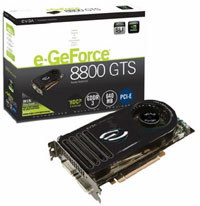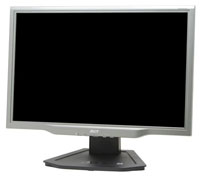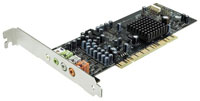Midrange Gaming Configuration
We've covered nearly all of the component choices necessary for a high-quality gaming solution already. The one major change that we would make would be to cut costs in most areas other than the graphics card, and then spend a large portion of the budget on getting a GPU that's as fast as possible. Here's what we came up with.
| Intel Mid-Range Gaming System |
| Hardware |
Component |
Price |
Rebates |
| Processor |
Intel Core 2 Duo E6300 (1.86GHz 2MB Shared) - Retail |
$185 |
|
| Motherboard |
Biostar TForce965PT (P965 775) |
$111 |
|
| Memory |
OCZ S.O.E 2x1GB DDR2-667 (OCZ2SOE6672GK) |
$221 |
$30 |
| Video Card |
eVGA GeForce 8800GTS 640MB (640-P2-N821-AR) |
$400 |
$20 |
| Hard Drive |
Seagate 320GB SATA 3.0Gbps 7200RPM 16MB (Barracuda 7200.10) |
$90 |
|
| Optical Drive |
LG Black 18X DVD+R (GSAH22N-BK) |
$36 |
|
| Case |
Cooler Master Centurion 534 (RC-534-KKN2-GP) |
$66 |
$10 |
| Power Supply |
Rosewill SLI 600W (RP600V2-S-SL) |
$73 |
|
| Display |
Acer AL2223Wd 22" 5ms (1680x1050) |
$314 |
|
| Sound Card |
Creative Sound Blaster X-Fi XtremeGamer 7.1 |
96 |
|
| Speakers |
Logitech X-530 5.1 70W Speakers |
$74 |
|
| Keyboard and Mouse |
Microsoft Comfort Curve 2000 B2L-00047 |
$28 |
|
| Operating System |
Windows XP MCE 2005 (with Vista coupon) |
$115 |
|
| Bottom Line |
|
$1809 |
$1749 |
 |
We pretty much took the base Intel midrange configuration and made several focused upgrades. The most significant change is going to be the inclusion of a GeForce 8800 GTS graphics card, and many people will be content to stop there. The GeForce 8800 GTS features DirectX 10 support (which of course will require Windows Vista and an updated public driver before it becomes useful) and it uses NVIDIA's new G80 core. We can't really evaluate DirectX 10 performance yet, but in currently shipping games the only single GPU solution that's faster than the 8800 GTS is the 8800 GTX. The GTS isn't a whole lot faster than AMD's X1950 XTX, and there are even a few games where it's slightly slower, but given the relatively similar prices and the improved feature set most gamers will prefer NVIDIA's offering right now.
 |
Besides the upgraded graphics card, we felt most gamers would appreciate moving to a larger LCD. We chose the Acer 22" LCD without HDCP support rather than the Sceptre we mentioned on the previous page, because many gamers really don't care too much about HDCP. We also added the larger 600W Rosewill power supply, and in order to get the most out of games we felt the inclusion of Creative's Sound Blaster X-Fi was warranted.
 |
Core 2 Duo generally does very well in gaming benchmarks, and anyone looking at doing even a moderate amount of overclocking will definitely get more mileage out of a Core 2 Duo chip. However, if you spend an equal amount of money on an AMD system, you can get an X2 4600+ that typically falls between the E6300 and E6400 in gaming performance (at stock speeds). Given the number of A-list games that currently benefit from multiple processor cores (all three of them!), you can even take things one step further and pick up a single core Athlon 64 3800+ to save even more money.
That said, we really hope 2007 will finally be the year where dual core processors begin to show more of a benefit in games. With such a high-end graphics card, the CPU could very well become a bottleneck, and several triple-A titles scheduled for the coming year look poised to put more of a strain on the CPU. While it might be interesting to contemplate using a single core processor with a high-end GPU in a gaming system, long-term that may prove to be a limiting solution and we don't recommend it.













43 Comments
View All Comments
dm - Friday, January 19, 2007 - link
Hey, I like this article. Very nicely written and "right on time"!!! Btw, if I may request, could you guys make a write up about "specialized" items? I mean, like this pico PSU and Mini-ITX combo:http://fanboyreview.blogspot.com/2006/01/tech-link...">http://fanboyreview.blogspot.com/2006/0...link-pow...
http://fanboyreview.blogspot.com/2006/02/press-rel...">http://fanboyreview.blogspot.com/2006/0...ss-relea...
I'd love to see you guys build one, bring it to the test bench, and tell use where to get those parts. I just can't find them :(
Le Québécois - Friday, January 19, 2007 - link
I think this is the first Buyer's guide from Anandtech.com that I read that doesn't completely include both Intel and AMD. Yes it still mention what AMD could be use if you don't go with the listed Intel configuration but it doesn't tell you the price or what motherboard you should buy if you would choose to go with AMD. I know AMD is not the best way to go right now but still I find this a little confusing when I go back in the "Mid-Range Buyer's Guide, September 2005" and find this :But still that guide provided us with both Intel and AMD options.
Yes AMD is on the first page with Intel but it's the only page for this guide. What's happening to Anandtech integrity? Or it's just the way every guides will appear from now on even if AMD manage to get back at Intel?
If it's the case, I don't think it's a good idea because some peoples are fanboys and will never go with AMD or Intel and leaving out either Intel or AMD from a guide may leave these persons in the dark since many of them don't take times to read every articles that are published on Anandtech.
JarredWalton - Saturday, January 20, 2007 - link
Honestly, I got tired of putting together system configurations that I really wouldn't recommend. The AMD configuration listed is very good for a midrange PC, so I included it. As a gaming platform, AMD is still fine, but if you want a high-end gaming system would you really want to pair it with a lesser CPU? Overclocking there's really not much point in getting a new AMD right now, I don't think - some of the lower end parts and the Opteron models can overclock pretty well, but when Core 2 leads in clock-for-clock comparisons and you can usually get an extra 500+ MHz out of it, it's just not even close.Really, I thought it would be more interesting to take a look at several different options for a midrange computer rather than doing the same old thing again. The way I see it, most of the changes made are minor upgrades to the CPU/mobo, so only the other parts are really changing. You could use the base AMD system and make the same upgrades, only keep the mobo constant, and you'd pretty much be fine. I still have several dozen PCs that have AMD processors and only one Core 2 of my own, for what it's worth. (No need to upgrade any of the systems right now, as they're fast enough.)
yyrkoon - Sunday, January 21, 2007 - link
This is from a motherboard that you guys recently did a spot light on in one of your CES articles. 900MHZ - 1.1 GHZ is a bad overclock ?
http://www.newegg.com/Product/CustratingReview.asp...">http://www.newegg.com/Product/CustratingReview.asp...
Post #5, and I suppose someone could possibly fabricated their review, but this one person isn't the only person on newegg claiming this motherboard is a very good overclocker, perhaps you guys should convince AMD + ABIT sending you parts for review ?
Now, on the reverse side, I'm still not quite sure it is worth investing in an AMD CPU for overclocking, Intels current CPUs seem a bit cheaper overall, but hey, the opterons might not be fully supported on this motherboard, but they seem to be working, and quite well, according to several reviewers.
JarredWalton - Sunday, January 21, 2007 - link
You can get Opterons to hit ~3.0GHz with pretty much full stability, but when those cost as much as an E6400 that will hit 3.5+ GHz with full stability, it's pretty clear why we think Core 2 is the better overclocking choice. A 50% or higher overclock is nothing to scoff at, but E6300 is basically only limited by motherboard and RAM in many cases, and E4300 ought to hit 100% overclocks routinely. (Yikes!)yyrkoon - Sunday, January 21, 2007 - link
Yeah, I never said it was a viable comparison, but for die hard AMD fans, its definately an option. I mean, what I would really like to see, is some real world hard data, on an Opteron vs maybe each of the conroe CPUs. I've little doubt, all CPUs overclocked, that every Conroe would outperform anything AMD, however, how much of a real world difference would it really make ?Some of us have already invested into AM2 systems, and could upgrade a good bit cheaper to an Opteron, vs. a C2D CPU, so the real question is, is it really worth the cost of the motherboard, to go that route, instead of just buying an Opteron? We've all seen your game numbers for FPS etc., but would those numbers really translate into a hugely noticeable difference ?
I for one, if gone C2D, would buy a top of the line i680 board (most likely ABIT), and probably an E6600, if gone AMD, an Opteron 1214-1216 (I like the even numbered, higher multiplier on the 1216), and the ABIT motherboard mentioned above. Also, since my business partner here just purchased the that ABIT AM2 board, I have the luxury of seeing it in action, before I purchase for myself.
Also, since i payed only $54 for my current system board, and not very much for the single core 3800+ im currently using, its not as though I'm out a whole lot, no matter what I do. One thing is for sure however, this motherboard WILL get replaced, I'm not too fond of it, and its not very stable compared to anything I've owned from ABIT.
JarredWalton - Monday, January 22, 2007 - link
How much of a difference it would make depends largely on what sort of application you're running, as well as the other hardware in the system. If you don't have a top end graphics configuration and you're worried about gaming performance, in most cases the difference between the various current processors is going to be very small. If you're running a couple of 8800 GTX cards, the difference could be quite a bit larger depending on resolution. I figure anyone that has the money to buy a couple of 8800 GTX GPUs should probably already have at least an E6600 processor, because if you're willing to spend that much money on graphics cards $300 on a processor doesn't seem like a whole lot.Other applications (3D rendering, video encoding, office tasks) will show more or less of a difference. Core 2 Duo should be faster in most of those, especially with overclocking, but if you never happen to run any of those tasks it really doesn't matter much. If you already have a decent AM2 setup and can hold out, I would be far more interested in waiting to see what the K8L processors can manage to do -- granted that appears to be about six months out, but I doubt anything significant is going to happen in the software market before then that would necessitate a CPU upgrade. (Maybe Vista might do it?)
yyrkoon - Monday, January 22, 2007 - link
Yeah, well I for one, am not too enthusiastic about the socket F platforms (assuming this is what you mean about K8L). I used to follow the road maps of each side, to the point that I would be easily disappointed when the chips actually arrived. Now, I just wait, and see what happens when it happens, at least, for CPUs. Personally, the technology I've been following for a while, thats not due out until perhaps quarter 3 is PCI-E v2.0, and the PCI-E to PCI-E peer to peer communications (potential of 160Gbit/s throughput . . .). Something tells me though, that either 1) this technology will be further out than quarter 3, 2) is all smoke an mirrors, 3) will cost WAAAAY more than 10GbE currently costs now.Anyhow, my point basically is, you can wish in one hand, and .... in the other, and see which one fills up faster. In other words, it wont happen, until it happens :)
JarredWalton - Tuesday, January 23, 2007 - link
I'm pretty sure AMD is going to release some sort of updated CPU (quad core maybe - not sure on that) for AM2 round about summer time. My understanding (which admittedly could be wrong) is that K8L will be available for socket F as well as AM2, just like the current K8 line. Socket F just supports multiple CPU sockets whereas AM2 is for single chips. That's why we have Opteron 12xx parts for AM2 and 22xx/82xx for socket F.As for PCI-E stuff, most of the new items won't really matter on the desktop. It's like having a PC with 80GB/s of memory bandwidth; if the CPU only needs 5-8GB/s everything else is just wasted.
Le Québécois - Saturday, January 20, 2007 - link
OK, thanks for taking some of your time to explain why you did this. I don't have any things personal against this approach since I do read every one of Anandtech articles and have no problem building a computer on my own.I understand you got tired of writing about 2 differents builds of computer (AMD and Intel) for every guide even if one of those isn't a good choice (computing power or cost). I just found it odd to see it at this time when AMD is no so bad (I would buy a Core 2 Duo if I was looking for a computer right now but I'm still not ready to change my old one) and not a some times ago when Intel was like AMD is today, if not worst, like in the Buyer's Guide where I took my quote from.
Now if I think about it, maybe it's a good thing since it will force the fanboys to do some real research before blindly buying AMD or Intel just because of the name.
One last thing, when you say :
Are you saying that you personally own those PCs?
If so can I ask what are you doing with such an amount of PCs?